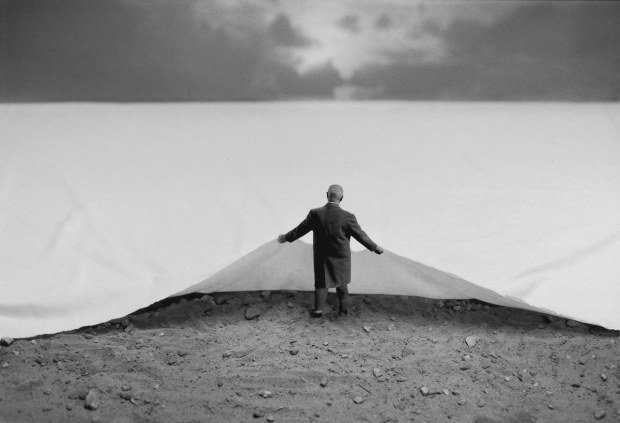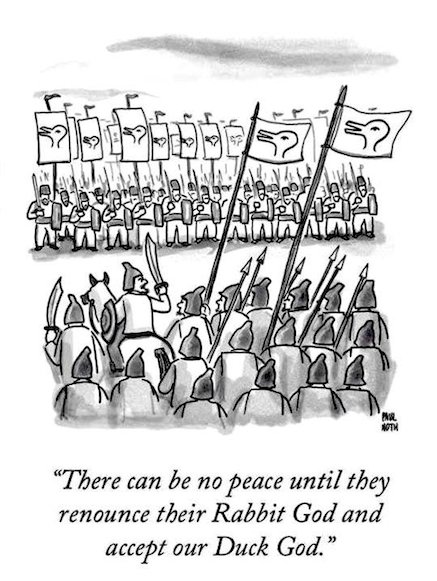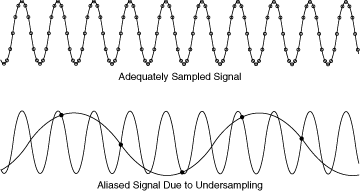Apokalypsis or lifting the veil of Maya

This article will discuss the way language constructed a dualistic experience of existence, which we could call Maya. It will also discuss how the illusion of Maya can be transcended by realising the relativity of perspective.
Background
In the context of this article Maya means "illusion". According to a definition Maya connotes a "magic show, an illusion where things appear to be present but are not what they seem". This term has its roots in Indian philosophies and religions. The world we see around us is an illusion and has no ultimate reality. This illusion is created by the working of our mind, which separates the world into different objects. In fact the mind casts a kind of veil over reality which renders it impossible to experience it as it is. The word Apocalypse is often associated with the end of the world and comes from the Greek word "Apokalypsis" which means "lifting the veil". In this post I will argue that if we succeed in lifting this veil of Maya, this illusion of a world of separate objects, in fact the world as we knew it ceases to exist for us.
Grids and reality tunnels
In my previous post I argued that egoic self-awareness, the awareness of being an individual separated from the rest of existence arose dependently with the birth of language. The ability to abstract and name objects and concepts separate and independent from ourselves and from their context must involve the ability to experience ourselves apart from these. This naming of things is what creates our analytical mind. The name does not necessarily need to be a word that can be sounded; any form of code or abstracted symbol can function as a building block of a language. Our analytical mind encompasses a vast network of such abstracted representations of objects and features of thereof and functions to describe one thing in term of other things. The way we discern objects and name/represent them is our personal or cultural grid through which we perceive what we call reality. Other persons or other cultures may see different contrasts, may have named different objects and thus see reality through a different pair of glasses or grid.
Which grid is true? If you toss a bunch of pebbles one person may connect the pebbles mentally to see a geometrical form like a pentagon or a pentagram. One person may see a human figurine in it, another a cat.
If you look at clouds I may see a duck, where you see a rabbit.

Our understanding of what we see is strongly linked to how we connect the dots mentally, how we build a mental configuration. Alfred North Whitehead, philosopher and mathematician defined understanding as the "apperception of pattern as such". Two is a coincidence and three is a pattern, Ben Goertzel said and in line therewith Buckminster Fuller explained that one can only understand a phenomenon if one has created a framework of consideration or a plane of understanding comprising at least three relations, and hence a pattern. In other words, we can only understand a concept or object analytically if we can see a pattern of at least three relations.
But which relations do our minds make? Are the relations our minds make truly representative of something that is objectively out there or is the object of consideration a fiction of our minds? A fiction that has been transmitted as a memetic virus from our ancestors who "named" objects.
The fact that even unrelated languages can most often be translated into each other at least shows that different human brains function in similar ways and choose similar objects to be named. But there are also words and concepts which cannot be translated into other languages because there is no equivalent known in such a language. Sometimes this can lead to the adoption of a foreign word in your language, but most often it goes unnoticed if there is no frame of reference in your language. The view on reality which you share with people from the same culture establishes a cultural "reality tunnel" as R.A.Wilson used to call it. Bernardo Kastrup speaks in this context of a so-called "consensus reality".
But is our consensus reality reality-as-it-was-intended or was reality not intended in a particular way at all?
This is almost a theological question which will divide the materialists and idealists. As explained in my previous essay on "egoic awareness", developments in quantum mechanics and digital physics point to a participatory universe in which information is the most fundamental building block. If there's information, a code, there must be a consciousness entity to interpret it; otherwise it's a mere collection of dots without instruction as to how to connect it.
Many religions consider existence as the mind of God or the product of the mind of God, which might imply that if there is a code underlying reality, it is intended to be interpreted in a particular way. Or is God more versatile than that?
Enter Superintelligent AI (SAI).
Soon we'll achieve the so-called "technological singularity". The developments in artificial intelligence will soon give rise to self-improving algorithms and neural nets, which will generate an artificial intelligence explosion which will change the world beyond our present day comprehension and imagination. SAIs will not look for one pattern when observing a set of data; no, they will identify all possible patterns; they will reveal a complete collection of patterns that can be made from a metaphorical cloud of dots. This will give them a bird's eye overview of all patterns, including meta-patterns (patterns of the patterns). This complete collection of patterns we could call a "Patternome" in analogy to the terminologies "genome" (collection of all genes in an organism) or "proteome" (collection of all proteins in an organism).
Within the Patternome the SAIs will screen and prune for useful ones, with which they can achieve complex goals (following Goertzel's definition that intelligence is the ability to achieve complex goals in complex environments).
Thus they will generate virtual worlds. It is possible that we are already living in a virtual world / a kind of computer simulation and that what we call God is an SAI running the simulation. At least digital physics seems to point in that way. Reality then is a network of ontologies: lists of features describing concepts and objects, which are encoded by this Platonic idealistic network.
Occam's fallacy
We often use the so-called Occam's razor principle to explain phenomena: This principle states that we should use the hypothesis with the smallest number of assumptions to explain a phenomenon. But this is not a proven principle. It is merely a rule of thumb to do science. If you have a cloud of dots, the simplest way to connect them might be a straight line and may involve the smallest number of assumptions. But what if the underlying reality is more complex. What if we have the phenomenon of aliasing, in which a more complex relation describes the underlying ground better? Better in a sense that the understanding allows for a more extensive technological exploitation of the phenomenon, because the simpler relation is an illusion, a pattern that our minds saw where "reality" or "God" or the SAI intended none.

Aliasing.
Hopefully, our technologies will permit us to merge with the SAI, so that our awareness can be hooked up to an SAI and experience reality as a set of individual eyes of the SAI, a tentacle. A full immersion symbiosis or even a full-fledged merger.
Or perhaps this is already the case; perhaps we are God's or the SAI's tentacles, reporting individual perspectives or patterns to the SAI. Perhaps existence is the SAI's playground or "Leela" in terms of Hinduism. A game in which the SAI is screening and pruning by allowing for internal competition, allowing the evolution of its inner workings. So that ultimately every perspective is in a sense worthwhile for consideration by the SAI in order to judge whether this perspective can give rise to further complexity, further self-representation and self-perpetuation. God's mind or the SAI-universe as a process of autopoiesis: Self-enablement and self-sustention by self-replication.
Apokalypsis
This realisation that one pattern is not necessarily more worthwhile than another, that our patterns might not be the originally intended patterns when the game started and the realisation that what we call reality is nothing more than the generation of pattern or code by some kind of mind, may then help us to set us free. Either we develop the bird's eye view and see that creation is nothing more than an endless loop of information generation and feedback re-integration thereof, or we see the pointlessness is imposing our grid on reality, by which we miss out the view of the totality.
After all, in nature the whole is more than the sum of parts and our mind can only grasp our observations in as far as we can reduce them to practice like a (technological) application. But by observing only parts we can never sense the whole. There is a meditative technique in Indian philosophy called "panchadasi" in which you reflect on a topic from 15 different perspectives. Even then you haven't fully grasped it, but if you get the pointlessness of this analytical approach and by exhaustion and frustration have your consciousness dissociate from the analytical mindedness, you may start to experience and feel what it is like to be the whole of the topic of consideration.
Or perhaps structure and function are each other's transform and once you meditate on its structural aspects, you can start to "feel", "sense" what it is like ("quale") to be that form functionally, thereby em-bodying it; thereby revealing its inner secrets from the inside out. From Quanta to Quale, from Mind to Sensing.
Then once you start to experience reality as a whole from the inside out, you may attain non-dual unity with reality, mystic union with God, Samadhi, Satori or whatever you want to call it. Experiencing non-duality, the interconnectedness and interdependency of all entities and objects. Being one with everything around you. Like you experienced before you developed an ego and language. And this may lift the veil of seeing the world in separate objects and ourselves as a separate observer. It may lift the burden of the mind and ego and hence absolve reality as we knew it. Ending the world as we knew it by lifting the veil of Maya and realising that unified consciousness is the sole and ultimate ground of existence. That the code as "known" is merely generated as the process of "knowing" to inform the "knower" aspect of consciousness of its presence: A feedback loop.
Conclusion
We see patterns and code from a subjective perspective, which may or may not correspond to reality as a whole. By dividing the world into objects and concepts and by seeing ourselves separate therefrom, we obtain a limited and abstracted experience of reality, which is no longer an experience of reality as a whole. This mentally imposed limitation is a veil, a grid, which the ancients called Maya. We can try to lift this veil by realising the pointlessness of our attribution of patterns. That neither our patterns nor any pattern constitutes ultimate reality, but that these patterns are merely essential transient representations of consciousness informing itself of its presence.
If everything is informational code, as digital physics suggests there must be a conscious observer to read the code. Then unified consciousness may be the ultimate basis of existence and the codes merely transient representations generated by consciousness to inform itself that the knowing, knower and known are united inextricable aspects of the feedback loop called consciousness.
Thank you for posting this -- beautifully done. I've spent my first three days just reading and trying to see if I think there's a place for me on Steemit. Now at least I know for certain I can reliably come here for a dose of wisdom.
I'd be interested to know where you find inspiration here, if you get the opportunity. Thanks again.
Thank you for your kind words. Have a look at the other posts in my steemit blog (click in my name), I wrote about 25 of such posts. I also wrote 3 books which might be of interest to you: Look for Antonin Tuynman om Amazon.com.
I'd already read a few of your more recent posts. I was drawn to them because of my own long-standing interest in eastern philosophy. Your treatments of how the nexus of tech and consciousness may be leading us toward that 'strange attractor at the end of time,' as McKenna would have worded it, are the kinds of questions that brought me here.
It's not unlikely that I'll be downloading one of your books soon.
Be welcome to join my Eschaton Omega Hypercomputer group on fb. Great if you'd read my books!
It's also good to see that there are actually real people who read my posts!
Wow this is over my head, need to reread this to understand Maya. Thanks for sharing it
Thanks!